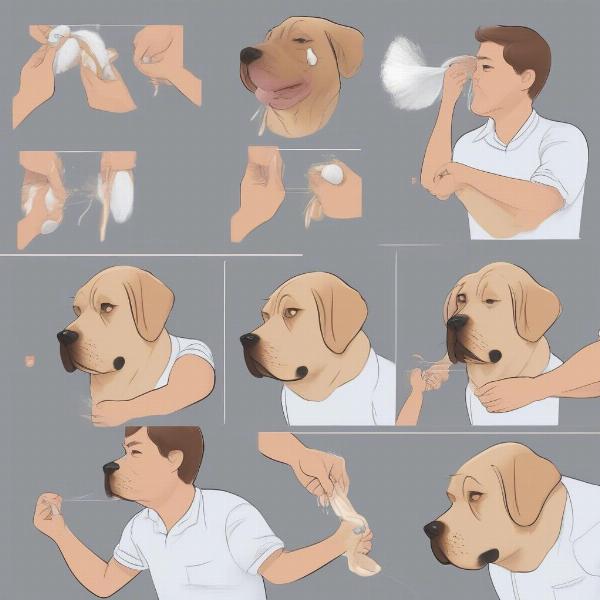Dog ear wash solutions are an essential part of any dog owner’s grooming kit. Regular ear cleaning helps prevent infections, removes wax and debris, and keeps your canine companion comfortable. This guide will cover everything you need to know about choosing and using the right dog ear wash solution for your furry friend.
Why is Dog Ear Wash Important?
Just like humans, dogs accumulate wax and debris in their ears. This buildup can lead to infections, discomfort, and even hearing loss if left untreated. Regular cleaning with a dog ear wash solution can help prevent these problems and keep your dog’s ears healthy. Some breeds, such as those with floppy ears like Cocker Spaniels and Basset Hounds, are particularly prone to ear issues due to reduced airflow. Therefore, they may require more frequent ear cleaning.
Choosing the Right Dog Ear Wash Solution
With so many dog ear wash solutions on the market, choosing the right one can be overwhelming. Look for a solution that is specifically formulated for dogs and avoids harsh ingredients that could irritate the delicate skin inside the ear. Some solutions contain antibacterial or antifungal agents to help combat infections. If your dog has sensitive skin or a history of ear problems, consult your veterinarian for recommendations.
How to Use Dog Ear Wash Solution
 Step-by-Step Dog Ear Cleaning Guide
Step-by-Step Dog Ear Cleaning Guide
Cleaning your dog’s ears is a straightforward process, but it’s crucial to do it correctly to avoid causing any harm. Here’s a step-by-step guide:
- Gather your supplies: dog ear wash solution, cotton balls or gauze pads, and treats to reward your dog.
- Hold your dog’s ear flap and gently fill the ear canal with the solution.
- Massage the base of the ear for about 30 seconds to help distribute the solution and loosen debris.
- Wipe away the excess solution and debris with a clean cotton ball or gauze pad. Do not insert anything into the ear canal deeper than you can see.
- Repeat on the other ear.
Signs of Ear Infection in Dogs
It’s important to be aware of the signs of an ear infection so you can seek veterinary care if necessary. These signs can include:
- Head shaking or tilting
- Scratching at the ears
- Redness or swelling in the ear canal
- Discharge from the ears
- Foul odor coming from the ears
If you notice any of these signs, contact your veterinarian. dog waterproof bed cover can help keep your dog’s bed clean and free from bacteria, which can contribute to ear infections.
Maintaining Ear Health
Regular cleaning with a dog ear wash solution is the best way to maintain your dog’s ear health. bulk dog bowls can be helpful for multi-dog households to prevent the spread of infections. However, it’s also important to dry your dog’s ears thoroughly after swimming or bathing to prevent moisture buildup, which can create a breeding ground for bacteria and yeast.
Dr. Emily Carter, a veterinarian specializing in canine care, emphasizes, “Prevention is key when it comes to ear health. Regular cleaning and proper drying can help avoid many common ear problems.” She also recommends checking your dog’s ears regularly for any signs of redness, swelling, or discharge. dog overalls can help protect your dog’s ears from dirt and debris while playing outdoors.
Conclusion
Keeping your dog’s ears clean with a quality dog ear wash solution is a vital part of responsible pet ownership. Regular cleaning, combined with careful observation, can help prevent infections and maintain your dog’s overall health and well-being. dog cover for sofa can also help maintain a hygienic environment, reducing the risk of ear infections.
FAQ
- How often should I clean my dog’s ears? Typically, cleaning once a week is sufficient for most dogs. However, if your dog is prone to ear infections or has floppy ears, more frequent cleaning may be necessary.
- Can I use hydrogen peroxide to clean my dog’s ears? It’s best to avoid using hydrogen peroxide, as it can irritate the delicate skin inside the ear canal.
- What if my dog resists ear cleaning? Try making the experience positive by using treats and praise. Start slowly and gradually increase the cleaning time as your dog becomes more comfortable.
- My dog keeps shaking his head after I clean his ears. Is that normal? Some head shaking is normal as your dog tries to remove any remaining solution. However, excessive head shaking could indicate a problem, so consult your veterinarian if you’re concerned.
- Can I use human ear drops on my dog? Never use human ear drops on your dog unless specifically directed by your veterinarian. Human ear drops can contain ingredients that are harmful to dogs.
- My dog has a lot of dark brown wax in his ears. What should I do? Dark brown or black wax could be a sign of an ear infection. Consult your veterinarian for diagnosis and treatment.
- What if my dog’s ears look red and inflamed after cleaning? Redness and inflammation could indicate irritation or an infection. Contact your veterinarian immediately.
Related Articles
About ILM Dog
ILM Dog is your trusted global resource for all things dog-related. We provide expert advice and practical tips on various aspects of dog care, including breed selection, health, training, nutrition, grooming, and product recommendations. From choosing the right dog ear wash solution to understanding your dog’s behavior, ILM Dog is here to support you throughout your journey as a dog owner. Contact us today for any questions or assistance: Email: [email protected], Phone: +44 20-3965-8624.